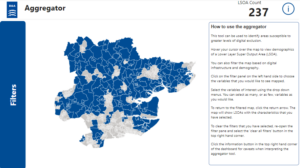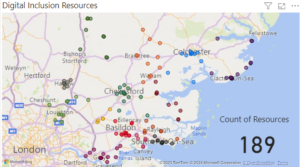As an increasing number of services and day-to-day activities are carried out or delivered online, residents with limited or no access to the internet may find themselves both socially and economically vulnerable. What’s more, research finds that digitally excluded populations are most concentrated in vulnerable groups (Helsper & Reisdorf, 2016). Consequently, life becomes even harder for these disadvantaged groups if for example they are unable to access online banking as high street bank branches close, or cannot complete online applications for state benefits, and may struggle to book GP appointments or contact their local councils.
To further complicate matters, Openreach has begun switching off the old copper cable network as they roll-out new superfast fibre across the country. This process is already underway and is expected to be completed by 2027. As a result, digitally excluded populations will no longer have traditional landlines and must adopt digital technology to stay connected. Aware of the implications of the above network changes, the Digital Connectivity team at Essex County Council approached us in the Data and Analytics team to develop a data-driven solution or tool to help identify Essex residents who are at risk of exclusion or who are already digitally excluded. With additional insight, the Digital Connectivity team hoped to be able to design a targeted intervention to contact and provide tailored support to these residents.
We began our analysis by posing the following question: who, and where, are Essex residents susceptible to digital exclusion?
To answer this question, we first needed to understand what underpins digital exclusion. Ofcom, the UK’s communications regulator, identifies three aspects of digital exclusion: affordability, access, and ability. Affordability refers to being able to pay for broadband, or digital devices such as mobile phones or laptops. Access can be understood as digital infrastructure- for instance, the strength of mobile signal or presence of internet service providers in an area. Finally, ability describes the extent to which someone can participate and engage with the digital world. This is sometimes known as ‘digital literacy’. These three aspects intersect and enmesh with one another. However, there is one common factor which underpins them all: poverty.
In the UK 8 million people have problems affording communications services (Ofcom, 2023). Since the onset of the cost-of-living crisis, broadband prices have increased. For many, there has been no choice but to disconnect. Citizen’s Advice estimate that people claiming Universal Credit (UC) are six times more likely to have disconnected their broadband than people not in receipt of state benefits.
In 2018 it was estimated that around a fifth of the UK population had either no, or extremely limited, digital skills. Of all cohorts, low levels of digital literacy disproportionately impact people in later life. In fact, Age UK estimate that over a third of over-75s don’t use the internet in any capacity. The impact of digital exclusion on people in later life is demographically uneven. For instance, those who are less affluent and less qualified are likely to feel digital exclusion especially acutely.
As mentioned earlier, Openreach is in the process of replacing legacy copper networks with digital and fibre infrastructure throughout the country. However, they have already communicated that for some sparsely populated rural areas laying new digital lines would not be economically feasible. In these areas, alternatives would have to be found to prevent the affected residents from being left in the dark.
 With a short-list of risk-factors of digital exclusion in hand, we set upon finding and procuring relevant datasets that would allow us to quantify their prevalence across the county. Procured datasets included ONS Census demographic and educational attainment data, Universal Credit claimant data from the Department for Work and Pensions, internet infrastructure and connection speed data from Ofcom, as well as mobile data provision levels (3G, 4G, etc.) as reported by various mobile providers.
With a short-list of risk-factors of digital exclusion in hand, we set upon finding and procuring relevant datasets that would allow us to quantify their prevalence across the county. Procured datasets included ONS Census demographic and educational attainment data, Universal Credit claimant data from the Department for Work and Pensions, internet infrastructure and connection speed data from Ofcom, as well as mobile data provision levels (3G, 4G, etc.) as reported by various mobile providers.
Each of these datasets also contained geo-spatial information at varying levels of granularity (ward, postcode, UPRN, longitude / latitude). This allowed us to create a dashboard in which each dataset and its corresponding measure of risk-factors of digital exclusion were layered on top of an interactive map of Essex. With this map we could identify areas where multiple risk-factors coincided, and which were therefore more likely to have groups of residents at risk of digital exclusion. Moreover, by filtering the map using different combinations of specific risk-factors, the Essex Digital team could target different areas with interventions tailored to support the specific needs of the local population.
 Essex Libraries offer access to free computers and WiFi the residents can use if they don’t have access to a computer or internet themselves. Additionally, Essex Libraries, in partnership with Adult Community Learning (ACL) offer residents courses and help to improve their digital skills and confidence using the internet. As an extra feature, we mapped out the locations of all libraries and digital literacy support provision across the county. This would enable the tool to also identify proximity of target areas to existing resources of support.
Essex Libraries offer access to free computers and WiFi the residents can use if they don’t have access to a computer or internet themselves. Additionally, Essex Libraries, in partnership with Adult Community Learning (ACL) offer residents courses and help to improve their digital skills and confidence using the internet. As an extra feature, we mapped out the locations of all libraries and digital literacy support provision across the county. This would enable the tool to also identify proximity of target areas to existing resources of support.
So, what will the outcomes from all of this work? Well, the dashboard we produced is already being put to use generating insights and supporting intervention design by the Digital Connectivity team. However, this is by no means a finished product. In the near term, we continue to search for additional barriers to digital connectivity and measures that could help us understand the prevalence of these barriers across the county. We are also looking into introducing additional functionality features to continue to develop the ease at which insights can be extracted from the tool.
If you're interested in learning more about the digital connectivity work, join us at Data Talks on 4 March 2024. The work will be demonstrated during this session Analytics in the Real World: Practical Insights and Applications register to secure your place.
Leave a comment